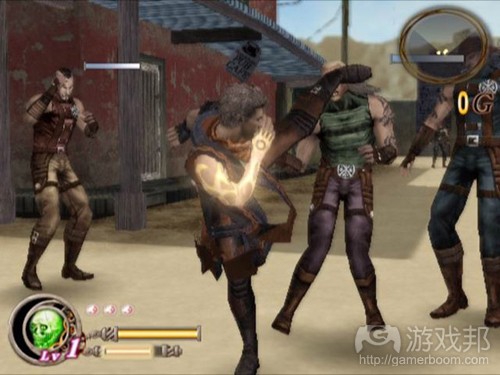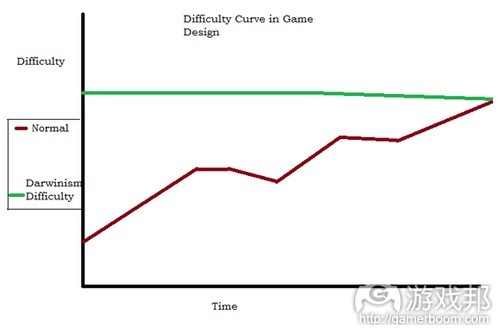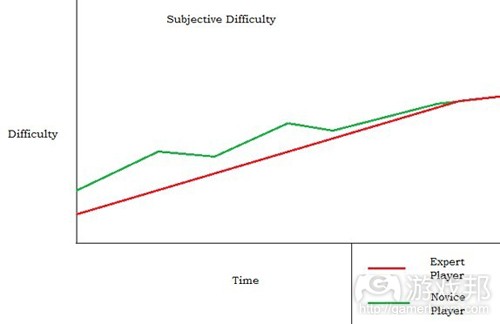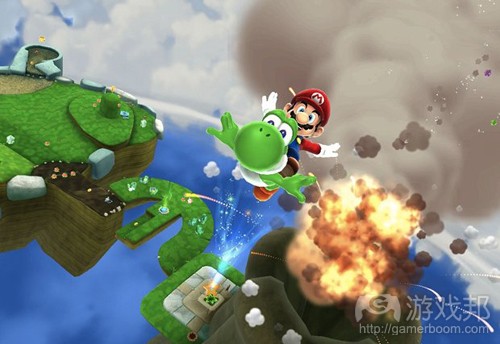分析游戏难度之主观难度的优势与挑战
作者:Josh Bycer
我在“达尔文难度”这篇文章中以《恶魔之魂》为例,提出了“主观难度”这个概念。但这个概念并不仅适用于那极为困难的游戏,甚至是《超级马里奥》这种自1996年问世以来就一直以易用性而著称的游戏也不例外。
在深入探讨这个问题之前,我们得先解释两个定义:
主观难度:根据玩家技能水平而设计的挑战。
安全度:玩家历尽艰辛,但最后仍能克服特定挑战的程度。
从技术上讲,我们可以说游戏中的任何挑战难度都取决于玩家主观技能水平,《街霸》高手玩家面对街机模式,当然不可能像从未接触过格斗游戏的玩家一样蹩脚。主观难度的关键元素在于,同时根据玩家的不同技能水平设计特定挑战。
要实现这一目标,就得让玩家在游戏开始之初就接触其中涉及的所有机制。要设计适用于不同技能等级玩家的关卡,就一定要呈现所有的机制供他们选择。如果某些关卡仅围绕一两个机制而设计,那么这就不叫主观难度,因为新手和高手玩家在这种情况下都只能接触同个难度的内容。
因此我们需要考虑到设置主观难度需厘清的一些问题。首先,随着游戏进程解琐机制并不能算是主观难度。玩过《银河战士》或者2D《恶魔城》的人就会发现,这些游戏中总有一些关键路径衍生出的有待解琐的分支。玩家一路探索游戏时,将通过与boss过招或者找到一些能量补充道具以解开新机制,以便进入之前那些限制访问的领域。
问题关键在于,玩家无法进入那些领域并不是他们水平不济,而是设计师有意所为。无论《恶魔城》的高手玩家有多厉害,他们也只得跟新手一样以同样的方式通关玩游戏。
其次,传统的难度等级设置也不能算是主观难度。从“安全度”这个概念可以看出,如果状态值(游戏邦注:例如,在“简单”关卡,敌人的杀伤力较小,在“困难”关卡,敌人杀伤力上升)成了决定不同难度等级的唯一要素时,那么所有的设计师都只要增加或者降低“安全度”,就可以完成难度设置了。
《神手》中的主观难度
PlayStation 2游戏《神手》有两种难度形式。刚开始,玩家可以选择一个难度等级。在游戏过程中,屏幕左下方有个仪表会始终显示当前的难度等级。
游戏难度会根据玩家的表现情况,在0级和死亡级(6级)之前浮动。如果玩家不慎受重伤或死亡,就会降低仪表中的数值,并因此而降低等级。玩家在游戏过程中受到的损害越小,其等级就会晋升得越高。
难度等级会带来两个影响:首先,它会影响AI的攻击强度。难度等级越小,敌人进行反击、群攻或使用必杀技的机率就越小,而高难度等级则与此相反。其次,高等级(尤其是死亡等级)关卡中会出现更多(和更困难)的敌人,迫使玩家提高适应能力。
《神手》会通过提升或降低难度来匹配玩家的技能水平,新手或高手都会经历同个关卡,只是新手遇到的挑战与高手不同罢了。
挑战的变化
主观难度的另一种形式是提供同个挑战的不同变体。例如《托尼霍克计划8》或《班卓熊:神奇螺丝》,这两者的挑战都含有基本、高级和专家级目标。
游戏中的每个挑战都会向最低限度地完成游戏(这也是最易完成目标的方法)的玩家颁发铜牌奖章,如果以更困难的方式克服挑战,就有可能赢得银牌或金牌奖章。例如,玩家在《托尼霍克计划8》中的竞赛中取得第五名,那就可以得到铜牌奖章,第二名就是银牌,两分钟内完成任务的第一名就可以拿金牌。
这种更困难的选项可以鼓励乐于参与挑战的玩家进行尝试,但只要拿到铜牌(或银牌)就已足够说明玩家已经“完成”挑战。
这种奖励系统在许多智能手机游戏中也很常见。有不少《割绳子》玩家总希望在每个关卡中都拿到3颗星——这并非完成挑战的必要行为,但却是完美主义者的必要选择。
3D版《超级马里奥》
《马里奥》是自NES时代以来一直备受欢迎的游戏系列,1996年3D版本的《超级马里奥64》的游戏设计变化较大。在之前版本的游戏中,每个关卡的路径和机制都完全采用线性设置,而3D版游戏则以开放式的关卡形式呈现了非线性特点。
《马里奥银河》系列和《恶魔之魂》的难度设置特点相当于一枚硬币的两面。
首先要申明一点,这两者都允许玩家在游戏开始之初让角色发挥所有的核心技能。在《马里奥》中,水管工的技能主要是跑、跳和旋转攻击等方式。
在《恶魔之魂》中,技能和机制主要根据与攻击、防御、精力管理和反击等与战斗有关的元素而设计(游戏邦注:值得注意的是,玩家在《马里奥银河》中可解琐一些提升能量的道具,但这仅限于一些特定的关卡或游戏场景)。
这两款游戏系列之间的偏差——《马里奥》可成为主观难度的典型而《恶魔之魂》不行的原因就在于,两者之间的关卡设计特点。《恶魔之魂》玩家一开始就可以接触所有的机制,游戏之初时就会遇到各种技能考验。但《马里奥银河》玩家虽然也能使用所有的机制,但可以在必要情况下才使用某些机制。
在达尔文难度概念中,玩家一开始就会接触到所有游戏机制(至少是多数游戏机制),并在随后的任务中有效使用这些机制。以下是该篇文章中的难度曲线图:
在这两种类型的游戏中,玩家在刚开始时都能接触到所有游戏玩法,所不同的是,采用达尔文难度的游戏要求玩家使用所有技能,而主观难度却允许玩家在高效体验游戏的情况下,自由选择要不要使用某些技能。这能够让不同技能水平的玩家体验同种内容,但可根据自己专长以不同的方式体验游戏。
《马里奥银河2》第一关就是主观难度设置的完美典型。在游戏半途中,马里奥需使用升降平台爬上一座山,高手玩家可使用较少的时间,以三级跳和高跳技能组合攀上山顶。
在该关卡接近尾声之时也出现了类似情况,玩家需跨越移动平台以穿过无底洞,新手可以仅使用基本的弹跳能力闯过这一关,但高手却可以使用远跳技能越过这个区域。
新手和高手在此面临的是同种挑战,但却可根据自己的技能水平以不同方式解决问题。除非新手之前就看过游戏指南,或者玩过《马里奥银河》,不然他们根本不知道怎么使用远跳技能。因为这种远跳技能考验出现在之后的游戏内容中。该游戏每次引进新技能都会显示一个指示牌,指导玩家如何操作新机制,并且会附上一个简单的小测试。
以下是游戏主观难度设置的曲线图:
从中可以看出,对于新手玩家来说,难度曲线会随着游戏进程而逐步上升,其中会伴随几个小起伏。而高手玩家的难度曲线起点较低,随后会持续稳步上升。
也许有人会问,“如果高手执行的是更困难的任务,其难度曲线不是应该比新手更高吗?”这里的原因就在于,即使高手应对的是更困难的挑战,他们的技能水平也足够令其轻松应对。举例来说,我们要是让从未接触举重的人举起40磅,让专业举重运动员举起60磅,缺乏经验的新手肯定会难以胜任,而这对身经百战的举重运动员来说却是小菜一碟。
随着游戏进程的发展,新手及高手的难度曲线最终会产生交集,这可以反映两种情况:
1.新手技能已经接近高手的水平;
2.游戏此时为新手、高手呈现的是同种内容。
在《马里奥银河》的常规游戏内容将尽之时,玩家应该已经完全了解马里奥的技能组合,也已经在最后一个阶段接受过所有的考验。这时游戏虽然仍在使用同种关卡设计方式,但其特点已接近于《恶魔之魂》的设置,并希望玩家能够把马里奥所有的技能都派上用场。
新手玩家在《马里奥银河》中获胜后会发现,游戏难度是根据自己的情况而发生变化。他们现在已经知道马里奥的不同技能,可以在游戏中的任何关卡使用这些技能。这与RPG游戏中的情况相似,高等级的玩家可以重返之前令自己恐惧的区域,然后彻底击败其中的敌人——不同的是,在《马里奥银河》中实现能力提升的是玩家本身,而不是游戏角色。
隐藏高级内容
在讨论主观难度的正反作用之前,我们得先看看《马里奥银河2》之后的内容设置,及其呈现的主观难度特点。针对不同玩家的技能水平,游戏在每个关卡中的一些难以进入的区域隐藏了一些特殊金币。
玩家找到一个金币就可以解琐彗星挑战,将自己返送回之前的关卡中,并用修改器增加旧关卡的难度。例如,第一个世界的彗星挑战要求玩家在倒计时环境中闯过第一关,这就促使玩家去寻找获胜的捷径。
新手的技能还达不到可找到特殊金币的水平,所以他们无法解琐这种挑战,但高手却可相对快速地找到金币。参与彗星挑战并非玩家通关的必要条件(因为玩家都可以通过常规玩法达到最后一个台阶并赢取足够的星星),但这却是增加高手游戏乐趣的元素。
随着新手技能的提升,他们之后也会开始找到隐藏的金币,并解琐彗星挑战。与玩常规游戏内容一样,新手最终也会晋升至高手玩家的行列,并解琐更多额外挑战。但高手玩家因为技能水平相对占优,他们不需要循序渐进地探索,在一开始就有可能解琐彗星挑战。
主观难度的优势和挑战
主观难度设置的优势在于其灵活而易用的特点。一方面,《马里奥银河》刚开始时很简单,降低了新玩家体验游戏的门槛;另一方面,这种设计风格也允许高手玩家一开始就体验挑战,提供额外内容考验他们的技能。
但问题就在于,设置主观难度并非易事,它需要融入不同设计方法。在一般游戏中,设计师只需关注每个挑战的渐进式发展,锁定同种用户即可。大家都清楚,多数游戏刚开始的内容都比后面要简单得多,但主观难度设计却有所不同。
此类设计师需兼顾不同技能水平的玩家需求,并以此设计每个关卡,这就需要他们投入更多时间创造额外内容。正因为如此,带有主观难度的游戏通常都有一些捷径和隐藏区域以供玩家探索,并使用所有的游戏机制。创造这种额外内容要求设计师吃透所有的游戏机制,设置可让不同技能水平的玩家以多种方式解决的难题。
作为设计师,你还得根据复杂性来排列游戏机制,以便玩家更好地理解游戏内容。《马里奥银河2》的设计师通过设置挑战,逐步引进每个机制,预留了充足的时间以便玩家消化每个游戏机制。不过有人可能就会发问,“三级跳转向高跳,然后再旋转跳,或者侧边弹跳转向旋转跳,再接着高跳,哪一种方法更复杂?”
主观难度与达尔文难度一样,如果使用得当,就可以让不同技能水平的玩家都获得丰富的游戏乐趣,同时又能在游戏过程中不断提升自己的水平。这类同时吸引多种玩家群体的游戏,无需简化设计就能收获大量用户。主观难度的目标是让新手玩遍游戏中的内容,在通关之后以自己升级后的技能,再以全新的视角从头体验游戏。(本文为游戏邦/gamerboom.com编译,拒绝任何不保留版权的转载,如需转载请联系:游戏邦)
Examining Subjective Difficulty: How Plumbers Can Fight Demons
by Josh Bycer
In my previous article on Darwinian Difficulty, there was a brief look, relating to Demon’s Souls, at the concept of Subjective Difficulty. However, the concept of Subjective Difficulty is not restricted to brutally hard titles, and one of the most famous and accessible franchises of all time has been an example of this since 1996.
Before we continue, it’s important to define two terms for the sake of this article:
Subjective Difficulty. Designing a challenge so that its severity is based on the player’s skill level.
Safety Net. The degree to which the player can mess up and still succeed at the specific challenge.
Technically, we can argue that any challenge in a game is subjective by skill; someone who is a grand master at Street Fighter is not going to have the same problems with arcade mode as a player that has never touched a fighting game before. The key component in Subjective Difficulty, however, is that specific challenges are designed for different skill levels at the same time.
To achieve this, the player must have access to all (or most) of the available mechanics from the get-go. In order to design levels that allow different levels of skill to work, the player must have the option to use all the mechanics. If the levels are only designed around using one or two of the available mechanics, then it’s not Subjective Difficulty, as both the novice and expert players are limited to the exact same thing.
With that said, there are a few considerations to understand about Subjective Difficulty. First is that unlocking mechanics as a form of progression is not considered Subjective
Difficulty. If you have ever played a Metroid game, or the latest 2D Castlevania titles, there are always paths or sections along the main route that are blocked or inaccessible. As the player explores the game, they’ll fight a boss or find a power-up that unlocks a new mechanic that can be used to enter the previously inaccessible area.
The point of contention is that it’s not the player’s fault that the area could not be reached, but the designer limiting the mechanics available. An expert player in Castlevania, no matter how good they are, will take the same path through the game as someone who is brand new.
Second is that the traditional use of difficulty levels is also not an example of Subjective Difficulty. Going back to the concept of the safety net, when the only difference between
difficulty levels is stat-based (i.e., on “easy”, enemies do less damage, but on “hard”, enemies do more damage) then all the designer is doing is raising or lower the safety net based on the difficulty setting.
Subjective Difficulty Levels: God Hand
However, that doesn’t mean that difficulty levels aren’t a factor. God Hand for the PlayStation 2 has two forms of difficulty. At the start of the game, the player chooses a difficult level; this in turn affects the second layer. During play, at all times a meter in the bottom left of the screen displays the current difficulty level.
The difficulty of the game can fluctuate between Level 0 and Level Die (or 6) based on the player’s performance. Taking significant damage or dying will lower the meter, which will drop the level down. The more the player avoids damage while continuing to make progress, the higher the level will rise.
The level of difficulty affects two things. First, it affects how aggressive the AI is. The lower the number, the less likely enemies will counterattack, attack in groups, or use their stronger attacks with the opposite more frequent at higher levels. The second detail is that at the higher levels (specifically Level Die) more (and more difficult) enemies will show up in the levels, forcing the player to adapt. Going back to the initial difficulty level at the start, the only things it determines is the starting level of the meter and how high it can go.
Playing God Hand, the game attempts to match the player’s skill level by raising or lowering the difficulty. Both a novice player and a skilled player are going to take the same path through the level, but what a novice player will be facing will be different compared to someone who is consistently performing well.
Challenge Variation
Another form of Subjective Difficulty is providing different variations of the same challenge. Games like Tony Hawk’s Project 8 or Banjo-Kazooie: Nuts & Bolts each feature challenges with basic, advanced and expert goals.
Every challenge in the games has a bare minimum to complete to get a bronze medal, which is the easiest way to finish it. There are also more difficult ways to attempt challenges, which could earn players a silver or gold medal. For example: in Project 8, completing a race while placing at least 5th would be a bronze award, placing 2nd gives silver, and placing 1st while finishing the race in under 2 minutes awards gold.
These harder considerations are always available to the player to try if they want and be awarded accordingly, but getting the bronze (or silver) award is good enough to check that challenge off as being “completed”.
This system is also popular in many smartphone games. A variation on it in the popular Cut the Rope finds players striving to capture three stars in each level — which are not essential for completion, but are necessary for completists.
The Mario franchise has been going strong since the NES era. When the series transitioned to 3D with 1996′s Super Mario 64, the game design changed profoundly. Before, every level was completely linear in its approach and mechanics; with the move to 3D, nonlinearity was introduced in the form of open levels.
The Super Mario Galaxy series and Demon’s Souls are two sides of the same coin.
Obviously, that statement needs to be clarified. Both games give the player access to all of the core abilities of the character from the start of the game. In Mario, the plumber’s abilities are movement-based (running, jumping) and his spin attack.
In Demon’s Souls, the abilities and mechanics revolve around combat: attack, defense, managing stamina, and counterattacks. (It’s worth noting that the player will unlock power-ups in the Super Mario Galaxy games, but these are usually confined to specific levels or gameplay scenarios.)
Now, the deviating point between the two series — and why Mario is a better example of Subjective Difficulty than Demon’s Souls — has to do with the level design. In Demon’s Souls, the player has access to all the available mechanics from the start and from the first stage is tested on all of them. In Mario Galaxy, the player has all the available mechanics and is not tested on all of them, but can use them if necessary.
Referring back to the concept of Darwinian Difficulty, the player is introduced from the very beginning of the game to all (or at least most) of the mechanics and is then tasked with using them effectively. Here is the difficulty chart from the previous article, as a point of reference:
In both types of games, the player has all of the gameplay tools from the outset. In a game with Darwinian Difficulty, the player is asked to use them all; in a game with Subjective Difficulty, the player may or may not use them at any time during the game and still play effectively. The difference between the two allows different skill levels to experience the same content, but handle it in different ways based on their expertise.
The first level in Super Mario Galaxy 2 is a perfect example of level design built around Subjective Difficulty. About halfway through the level, Mario has to use ascending and descending platforms to climb up a hill. Expert players can use a combination of Mario’s triple jump and wall jump to get up the hill in a fraction of the time a novice might take.
There’s another example near the end of the level. The player is tasked with maneuvering over bottomless pits by traversing moving platforms. A novice player can get through this entire area using nothing but Mario’s basic jumping ability, and be tested with this design. However, an expert player can simply bypass the entire area by performing a long jump across the pits.
Both the novice and expert player have the same challenge, but handle it differently based on their skill levels. Unless the novice player has read the manual or played Super Mario Galaxy, at that point they probably have no idea how to perform a long jump, and that’s perfectly fine. The first mention and test of using the long jump ability comes later on, at the same time Mario gets the cloud power-up. The in-game introduction to each of Mario’s abilities is signified by a signpost showing the player how to perform the mechanic, followed by a simple test.
The following graph shows the difficulty curve of a subjective game:
For the sake of the article, this chart only represents the normal content of the game; we’ll touch on post-game content further on. As you can see, for the novice player, the game’s difficulty curve follows the normal progression — a steady progress higher across the chart with a few dips here and there. Meanwhile, an expert player starts out lower on the curve and makes a continual progression.
Now, you may be asking, “If the expert player is taking a harder course, shouldn’t the curve be higher than for the novice?” The reason it isn’t goes back to the concept of Subjective Difficulty. Even though the expert player is doing something harder, their skill level at the game makes it easier for them. For example, if we ask someone who has never lifted weights to lift 40 pounds, and a professional weightlifter to lift 60 pounds, the novice is going to struggle due to their inexperience. However, the weightlifter, used to lifting much heavier loads, wouldn’t even sweat.
As the game progresses there should come a point where the difficulty curves converge indicating two things:
1. The novice player has reached the same skill level as the expert player.
2. The game is now challenging both groups with the same content.
At the end of the regular content in Super Mario Galaxy, players are expected to fully understand Mario’s move set, and are tested on it all in one final stage. The same philosophy of designing the levels is still used, but now the game is more akin to Demon’s Souls, expecting the player to make use of all of Mario’s abilities to win.
Novice players who do manage to beat Super Mario Galaxy will find that the game has changed for them. Now that they understand all of the different abilities Mario has, they can now use them anywhere in the game. It’s similar to how in an RPG, a higher level player can return to a once difficult spot and utterly demolish it — but what’s leveled up is the player, not the character.
Handling Optional Content
Before we talk about the pros and cons of Subjective Difficulty, we need to take a look at how post-game content worked in Super Mario Galaxy 2, and how it plays off of the concept of Subjective Difficulty. Fitting into the theme of developing level design for different skill levels, there are special coins hidden in each level, most often placed in harder-to-reach areas.
Each coin found will unlock a comet challenge, which sends players back through older levels with modifiers to make them more difficult. For example, in the first world, the comet challenge requires the player to run through the first level with a timer counting down, requiring the player to use the shortcuts to win.
Novice players will not have access to these challenges, as they are not good enough yet to reach the special coins, but the expert players should find them relatively quickly. The comet challenges aren’t required to beat the game, as players will earn more than enough stars through regular play to reach the final stage, but they are there for expert players who want more.
As novice players become more skilled at the game, they will start to find the hidden coins and unlock comet challenges. Like with the regular game content, novice players should eventually reach the same point as the expert players, allowing them to tackle the additional challenges. Expert players, however, don’t have to wait, and if they are good enough at the start of the game, they can begin comet challenges relatively early in the game.
The Advantage, and the Challenge, Of Designing For Subjective Difficulty
The advantage of Subjective Difficulty revolves around accessibility. Games like Super Mario Galaxy allow the designer to have their cake and eat it too, in a sense.
On one hand, the game starts out simple enough, easing new players into the game without throwing them right into the thick of things. On the other hand, this design style allows expert players to be rewarded with areas suited for them from the beginning, and offers additional content to test their skills.
Now, the problem is that Subjective Difficulty is that it’s hard to pull off and requires a different kind of design. In a normal game, the designer will look at each challenge progressively, with one group in mind. You know that a challenge in the beginning of the game is going to be easier than one found later on, but Subjective Difficulty is different.
Essentially, the designer will have to design each level for different skill levels at the same time, requiring more time to create the content. Because of this, there are usually more shortcuts and hidden areas in games with Subjective Difficulty which allow gamers to fully use the mechanics. Creating this additional content requires an extensive understanding of the mechanics of the game, to set up challenges that can be handled in multiple ways at different levels of skill.
As a designer, you also need to rank your mechanics in terms of complexity to understand the best order for the player to understand them. Going back to Super Mario Galaxy 2, the designers slowly introduced each mechanic officially to the player through set challenges, giving ample time for the player to understand one mechanic before introducing another. This leads to asking questions like, “What is more complex to use, a triple jump into a wall jump followed by a spin jump, or a sideways flip, into a spin, followed by a wall jump?”
Subjective Difficulty, like Darwinian Difficulty, requires an expert touch to achieve. When pulled off, it allows gamers to enjoy the game regardless of skill level, while seeing improvements in their skill over the course of the game. By keeping multiple groups of gamers engaged, the game will attract a larger audience without having to simplify the design of the game. Ultimately, the goal of Subjective Difficulty is that the novice players should achieve a full circle of play, after finishing the game they can replay the game again, but using their improve ability to see the game in a different light.(source:gamasutra)











































 闽公网安备35020302001549号
闽公网安备35020302001549号